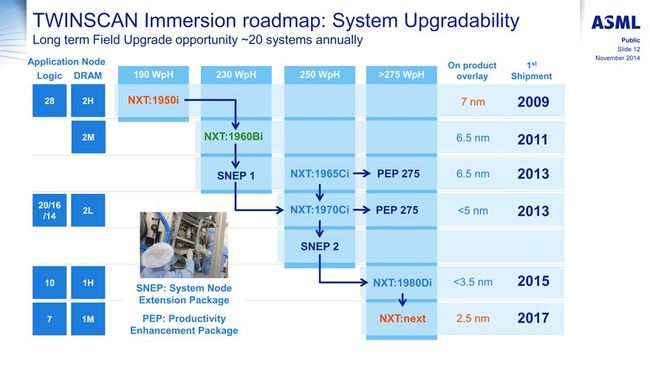Roadmap
The TWINSCAN NXT:1980Di Step-and-Scan system is a high-productivity, dual-stage immersion lithography tool designed for volume production 300-mm wafers at the sub 10-nm node.
The TWINSCAN NXT:1980Di is equipped with the successful in-line catadioptric lens design, having a numerical aperture (NA) of 1.35 – the highest in the industry.
In-situ measurement and correction of optic aberrations enable maximum imaging performance for each wafer exposed when imaging at very low-k1.
Advanced in-situ metrology per wafer together with a comprehensive set of options to input off-line metrology data to the scanner enable maximum overlay, focus and CDU performance on product wafers.
By combining high productivity and excellent image resolution with unprecedented overlay and focus performance, the TWINSCAN NXT:1980Di addresses multiple patterning requirements and thus provides a cost-effective solution for the sub 10-nm nodes.
Key feature and benefits
Vastly Improved Overlay Performance
Wafer table with improved flatness & wafer load grid, improvements on grid setup and layout dependent grid calibration ensure best possible full wafer matched overlay performance using customer layouts.
Application dependent contributions to overlay are reduced by active reticle cooling combined with improved reticle conditioning at the Reticle Handler.
Vastly Improved Focus Performance
Grid calibration and setup improvements in conjunction with improved wafer table flatness improve focus uniformity. A new Immersion Hood minimizes disturbance forces in the optical column and improved control of the reticle and wafer stages enhance the benefit further.
1.35-NA 193-nm Catadioptric Projection Lens
Production resolutions down to 40 nm (C-quad) and 38 nm (dipole). In-line catadioptric lens design supporting full 26 x 33-mm field size, 4X reduction and reticle compatibility with existing designs. Lens elements are equipped with manipulators to correct for optical aberrations, thus enabling maximum productivity for low-k1 applications.
FlexRay Prepared Illuminator for Maximum Flexibility
The FlexRay Prepared Illuminator extends the range of conventional and off-axis illumination to enable advanced pupil shaping for low-k1 imaging. Since the system will be hardware prepared it can be upgraded to full FlexRay functionality, and thus support an unlimited range of freeform pupil shapes by means of a simple software upgrade.
In-Situ Metrology per wafer exposure
Innovative focus control and field-by-field leveling measurement using ultra violet light significantly reduces the system's sensitivity to process stack variations during off-line mapping of the wafer surface. Furthermore the sensor has an increased measurement density which allows for improved leveling accuracy at the edge of the wafer.
The Parallel ILIAS (PARIS) sensor allows for a parallel measurement of optical aberrations throughout the projection slit, thus enabling a more accurate alignment, improved reticle heating correction and on the fly lens heating correction.
Increased Productivity and Reduced Defectivity
Proven 6-kHz ArF laser technology provides high power to support high throughput and is equipped with novel gas lifetime extensions to reduce downtime.
Immersion hood design improvements widen the window to optimize defectivity using low contact angle resists without topcoat.
Comprehensive service package together with TWINSCAN NXT:1980Di maintenance scheduler which takes advantage of system idle time to perform required routine maintenance enables best optimization of system availability.
Focus Spot Monitoring and Cleaning
The SpotLess 2 Wafer Table Cleaning System automatically cleans excessive focus spots caused by particles on the exposure chuck without operator intervention.
Litho-Cell Stability and Performance Control
BaseLiner is providing long-term stability for matched machine overlay, focus uniformity and mean focus of a scanner. It controls overlay and focus to a previous fingerprint. The efficiency is gained by offering high speed, off-line, YieldStar assisted metrology.
As a result of this, less scanner availability investment is needed for dense overlay and focus calibrations. Also overlay WIP impact and WIP qualification time is minimized by restoring the previous (matched) overlay fingerprint after occurrence of a service action that might have changed the overlay fingerprint.
Computing platform
The system is delivered with proprietary ASML TWINSCAN software based on the Linux/Voyager operating system.
Separate computing hosts are used for data access and scanner control offering the following automation interfaces: SECS, EDI, and EDA.


